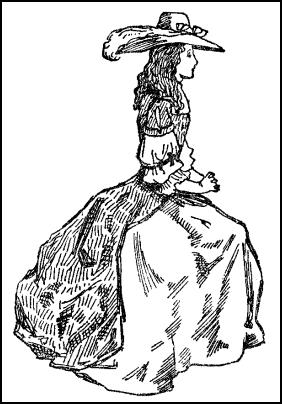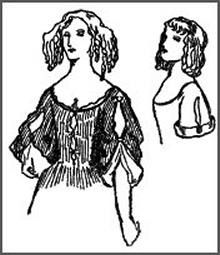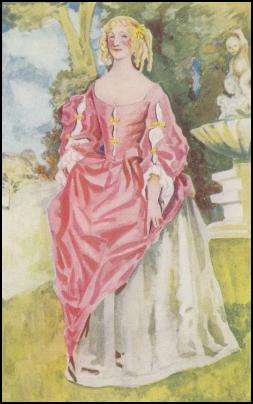By Pauline Weston Thomas for Fashion-Era.com
- King Charles II - 1660 - 1685 - Stuart Dynasty Restoration Era
- MAN OF THE TIME OF CHARLES II - 1660-1685
- A MAN OF THE TIME OF CHARLES II - 1660-1685
- A WOMAN OF THE TIME OF CHARLES II - 1660-1685
- PEPYS AND CLOTHES
- Stuart -The Restoration of the Monarchy - King Charles II - 1660-1685
This costume history information consists of Pages 365-382 of the chapter on the mid 17th century dress in the 25 YEAR REIGN era of Charles The Second 1660-1685 and taken from English Costume by Dion Clayton Calthrop.
The 36 page section consists of a text copy of the book ENGLISH COSTUME PAINTED & DESCRIBED BY DION CLAYTON CALTHROP. Visuals, drawings and painted fashion plates in the book have a charm of their own and are shown amid the text. The book covers both male and female dress history of over 700 years spanning the era 1066-1830.
This page is about restoration dress in the reign of Stuart King Charles II 1660-1685.
For the Introduction to this book see this introduction written by Dion Clayton Calthrop. I have adjusted the images so they can be used for colouring worksheets where pupils add some costume/society facts.
My comments are in italics.
Stuart Dynasty Restoration Era - King Charles II - 1660-1685
CHARLES THE SECOND
Reigned twenty-five years: 1660-1685.
Born 1630. Married, 1662, Katherine of Portugal.
THE MEN AND WOMEN
England, apparently with a sigh of relief, lays aside her hair shirt, and proves that she has been wearing a silk vest under it. Ribbon-makers and wig-makers, lace-makers, tailors, and shoemakers, pour out thankful offerings at the altar of Fashion.

One kind of folly has replaced another; it is only the same goddess in different clothes. The lamp that winked and flickered before the stern black figure in Geneva bands and prim curls is put to shame by the flare of a thousand candles shining on the painted face, the exposed bosom, the flaunting love-locks of this Carolean deity.
Huge Periwigs - Stuart Restoration Era 1660s
We have burst out into periwigs, monstrous, bushy; we have donned petticoat breeches ruffled like a pigeon; we have cut our coats till they are mere apologies, serving to show off our fine shirts; and we have done the like with our coat-sleeves, leaving a little cuff glittering with buttons, and above that we have cut a great slit, all to show the marvel of our linen.
MAN OF THE TIME OF CHARLES II - 1660-1685
There were two distinct forms of dress for men in the reign of Charles II. In the years immediately after the monarchy restoration short jackets and frilled ribbons abounded. This shows the dress favoured by many men during the first half of the reign. The main feature of is the volume of ribbon groups and ribboning, a short sleeve jacket to display the fulsome sleeve of the full shirt.
Frilled Breeches
Those of us who still wear the long wide breeches adorn them with heavy frills of deep lace, and sew bunches of ribbons along the seams.
Busy Lace Cravats
We tie our cravats in long, stiff bows or knot them tight, and allow the wide lace ends to float gracefully.
Feather Hats, Shoes & Cloaks
Our hats, broad-brimmed and stiff, are loaded with feathers; our little cloaks are barred with silk and lace and gold cord; our shoes are square-toed and high-heeled, and are tied with a long-ended bow of ribbon.
Ribbons Everywhere
Ribbon reigns triumphant: it ties our periwigs into bunches at the ends; it hangs in loops round our waists; it ties our shirt-sleeves up in several places; it twists itself round our knees.
It is on our hats and heads, and necks and arms, and legs and shoes, and it peers out of the tops of our boots. Divines rave, moralists rush into print, to no purpose.
Mid C17th Fashion History Terms
The names seem to convey a sense of luxury: dove-coloured silk brocade, Rhingrave breeches, white lutestring seamed all over with scarlet and silver lace, sleeves whipt with a point lace, coat trimmed and figured with silver twist or satin ribbon; canvas, camblet, galloon and shamey, vellam buttons and taffety ribbons.
The Cannons - Bunches of Knee Ribbons 1660
The cannons, those bunches of ribbons round our knees, and the confidents, those bunches of curls by our ladies' cheeks, do not shake at the thunderings of Mr. Baxter or other moral gentlemen who regard a Maypole as a stinking idol. Mr. Hall writes on 'The Loathsomeness of Long Hair,' Mr. Prynne on 'The Unloveliness of Lovelocks,' and we do not care a pinch of rappe.
Facial Hair & Patches
Little moustaches and tiny lip beards grow under careful treatment, and the ladies wear a solar system in patches on their cheeks.
The Ladies

The ladies soon escaped the bondage of the broad Puritan collars, and all these had hid was exposed.
Ladies Sleeves
The sleeves left the arms bare to the elbow, and, being slit above and joined loosely by ribbons, showed the arm nearly to the shoulder. The sleeves of these dresses also followed the masculine fashion of little cuffs and tied-up linen under-sleeves. The bodices came to a peak in front and were round behind.
The Skirts
The skirts were full, satin being favoured, and when held up showed a satin petticoat with a long train.
Fore Top Hair Loop Lock
The ladies, for a time, indulged in a peculiar loop of hair on their foreheads, called a 'fore-top,' which gave rise to another fashion, less common, called a 'taure,' or bull's head, being an arrangement of hair on the forehead resembling the close curls of a bull. 
The loose curls on the forehead were called 'favorites'; the long locks arranged to hang away from the face over the ears were called 'heart-breakers'; and the curls close to the cheek were called 'confidents.'
Ladies Travelling Cloaks
Ladies wore cloaks with baggy hoods for travelling, and for the Mall the same hats as men, loaded with feathers.
I am going to leave the change in dress during this reign to the next chapter, in which you will read how it struck Mr. Pepys.
§
A Change In Dress Styles From The Old Look To The New Look
This change separates the old world of dress from the new; it is the advent of frocked coats, the ancestor of our frock-coat.
It finishes completely the series of evolutions beginning with the old tunic, running through the gown stages to the doublet of Elizabethan times, lives in the half coat, half doublet of Charles I, and ends in the absurd little jackets of Charles II, who, sartorially, steps from the end of the Middle Ages into the New Ages, closes the door on a wardrobe of brilliant eccentricity, and opens a cupboard containing our first frock-coat.
Samuel Pepys
PEPYS AND CLOTHES

It is not really necessary for me to remind the reader that one of the best companions in the world, Samuel Pepys, was the son of a tailor.
Possibly - I say possibly because the argument is really absurd - he may have inherited his great interest in clothes from his father. You see where the argument leads in the end: that all men to take an interest in clothes must be born tailors' sons. This is no more true of Adam, who certainly did interest himself, than it is of myself.
Brief Bio on Pepys
Pepys was educated at St' Paul's School, went to Trinity College, Cambridge, got drunk there, and took a scholarship. He married when he was twenty-two a girl of fifteen, the daughter of a Huguenot.
He was born in 1633, three years after the birth of Charles II, of outrageous but delightful memory, and he commenced his Diary in 1660, the year in which Charles entered London, ending it in 1669, owing to his increasing weakness of sight.
He was made Secretary to the Admiralty in 1672, in 1673 he became a member of Parliament, was sent to the Tower as a Papist in 1679, and released in 1680. In 1684 he became President of the Royal Society, and he died in 1703, and is buried in St' Olave's, Crutched Friars.
Pepys mentions, in 1660, his coat with long skirts, fur cap, and buckles on his shoes. The coat was, doubtless, an old-fashioned Cromwellian coat with no waist.
Later he goes to see Mr. Calthrop, and wears his white suit with silver lace, having left off his great skirt-coat. He leaves Mr. Calthrop to lay up his money and change his shoes and stockings.
He mentions his scarlet waistclothes, presumably a sash, and regards Mr. John Pickering as an ass because of his feathers and his new suit made at the Hague.
Wide Cannons

He mentions his linning stockings and wide cannons.
This mention of wide cannons leads me to suppose that at this time any ornament at the knee would be called cannons, whether it was a part of the breeches or the stockings, or a separate frill or bunch of ribbons to put on.
On July 1, still in the same year, comes home his fine camlett cloak and gold buttons; also a silk suit. Later he buys a jackanapes coat with silver buttons. Then he and Mr. Pin, the tailor, agree upon a velvet coat and cap ('the first I ever had'). He buys short black stockings to wear over silk ones for mourning.

On October 7 he says that, long cloaks being out of fashion, he must get a short one.
He speaks of a suit made in France for My Lord costing £200. He mentions ladies' masks.
In 1662 his wife has a pair of peruques of hair and a new-fashioned petticoat of sancenett with black, broad lace.
Smocks are mentioned, and linen petticoats.
He has a riding-suit with close knees.
His new lace band is so neat that he is resolved they shall be his great expense. He wears a scallop. In 1663 he has a new black cloth suit, with white linings under all - as the fashion is - to appear under the breeches.
A WOMAN OF THE TIME OF CHARLES II - 1660-1685
The costume plate shows a woman who has adopted the fair golden locks hairstyle and twirled into ringlets which are tied with a ribbon which is dressed over a frame at the sides.
The Queen wears a white-laced waistcoat and a crimson short petticoat. Ladies are wearing hats covered with feathers.
God willing, he will begin next week to wear his three-pound periwig.
He has spent last month (October) £12 on Miss Pepys, and £55 on his clothes. He has silk tops for his legs and a new gown. He has a close-bodied coat, light-coloured cloth with a gold edge. He sees Lady Castlemaine in yellow satin with a pinner on.
In 1664 his wife begins to wear light-coloured locks.
In 1665 there is a new fashion for ladies of yellow bird's-eye hood. There is a fear of the hair of periwigs during the Plague. Even in the middle of the Plague Pepys ponders on the next fashion.
In 1666 women begin to wear buttoned-up riding-coats, hats and periwigs.
On October 8 the King says he will set a thrifty fashion in clothes. At this momentous date in history we must break for a minute from our friend Pepys, and hear how this came about.
Evelyn had given the King his pamphlet entitled 'Tyrannus, or the Mode'. The King reads the pamphlet, and is struck with the idea of the Persian coat. A long pause may be made here, in which the reader may float on a mental cloud back into the dim ages in the East, and there behold a transmogrified edition of his own frock-coat gracing the back of some staid philosopher.
Evelyn had also published 'Mundus Muliebris; or, the Ladies' Dressing-Room Unlocked.'
A MAN OF THE TIME OF CHARLES II - 1660-1685

On or about October, 1666 there was a clear change which came over men's dress. John Evelyn introduced Charles II to the new-fashioned vest or body-coat.
So, only one month after the Great Fire of London, only a short time before the Dutch burnt ships in the Medway, only a year after the Plague, King Charles decides to reform the fashion.
By October 13 the new vests are made, and the King and the Duke of York try them on.
On the fifteenth the King wears his in public, and says he will never change to another fashion. 'It is,' says Pepys, 'a long cassocke close to the body, of black cloth and pinked with white silk under it, and a coat over it, and the legs ruffled with black ribband like a pigeon's legs'.
Ladies Short Skirts - Stuarts 1666
The ladies, to make an alteration, are to wear short skirts. Nell Gwynne had a neat ankle, so I imagine she had a hand in this fashion.
On October 17 the King, seeing Lord St' Alban in an all black suit, says that the black and white makes them look too much like magpies. He bespeaks one of all black velvet.
Sir Philip Howard increases in the Eastern fashion, and wears a nightgown and a turban like a Turk.
On November 2 Pepys buys a vest like the King's.
On November 22 the King of France, Louis XIV, who had declared war against England earlier in the year, says that he will dress all his footmen in vests like the King of England. However, fashion is beyond the power of royal command, and the world soon followed in the matter of the Persian coat and vest, even to the present day.
Next year, 1667, Pepys notes that Lady Newcastle, in her velvet cap and her hair about her ears, is the talk of the town. She wears a number of black patches because of the pimples about her mouth, she is naked-necked (no great peculiarity), and she wears a just au corps, which is a close body-coat.
Pepys notices the shepherd at Epsom with his wool-knit stockings of two colours, mixed. He wears a new camlett cloak. The shoe-strings have given place to buckles, and children wear long coats.
In 1668 his wife wears a flower tabby suit ('everybody in love with it').
He is forced to lend the Duke of York his cloak because it rains. His barber agrees to keep his periwig in order for £1 a year. He buys a black bombazin suit.
In 1669 his wife wears the new French gown called a sac; he pays 55s. for his new belt. His wife still wears her old flower tabby gown. So ends the dress note in the Diary.
Stuart -The Restoration of the Monarchy - King Charles II - 1660-1685
- MAN OF THE TIME OF CHARLES II - 1660-1685
- A MAN OF THE TIME OF CHARLES II - 1660-1685
- A WOMAN OF THE TIME OF CHARLES II - 1650-1685
- PEPYS AND CLOTHES
CHARLES THE SECOND
Reigned twenty-five years: 1660-1685.
Born 1630. Married, 1662, Katherine of Portugal.
This costume history information consists of Pages 365-382 of the chapter on the mid 17th century dress in the 25 YEAR REIGN era of Charles The Second 1660-1685 and taken from English Costume by Dion Clayton Calthrop.
The 36 page section consists of a text copy of the book ENGLISH COSTUME PAINTED & DESCRIBED BY DION CLAYTON CALTHROP. Visuals, drawings and painted fashion plates in the book have a charm of their own and are shown amid the text. The book covers both male and female dress history of over 700 years spanning the era 1066-1830.
This page is about restoration dress in the reign of Stuart King Charles II 1660-1685.
My comments are in italics.
Page Added 16 August 2010. Ref:-810.